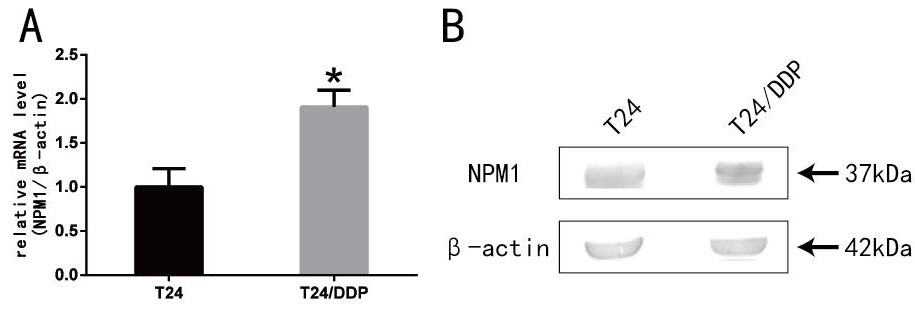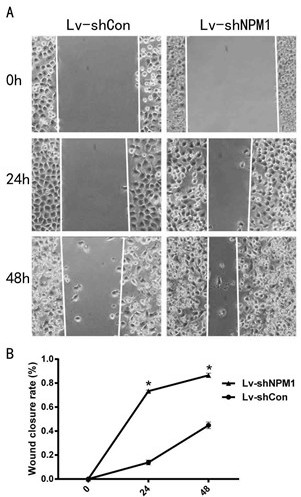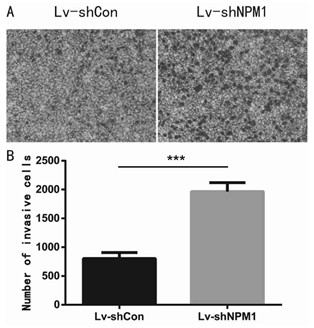An npm1 knockout human bladder cancer t24/ddp cell line
A technology for bladder cancer cells and cell lines, which can be applied to genetically modified cells, cells modified by introducing foreign genetic material, viruses/phages, etc., and can solve problems such as poor prognosis of bladder cancer.
- Summary
- Abstract
- Description
- Claims
- Application Information
AI Technical Summary
Problems solved by technology
Method used
Image
Examples
Embodiment 1
[0021] Example 1 Cell recovery, culture, passage, cryopreservation and maintenance of drug resistance
[0022] Take out the cell cryovial from the liquid nitrogen irrigation, quickly put it into a 37°C water bath and shake it to dissolve as soon as possible. Use a 75% alcohol cotton ball to sterilize the tube wall and mouth of the cryopreservation tube. Use a pipette to remove the cells. Transfer to a 15ml centrifuge tube, add 3ml of medium at the same time, centrifuge at 800rpm for 5 minutes, discard the supernatant, add 1ml of RPMI1640 medium containing 18% fetal bovine serum to resuspend the cells, and blow the cells into a single cell suspension. It was transferred into a culture flask for cultivation, 4 ml of culture medium was added, and cultured in a 37°C, 5% CO2 incubator. Passage when cells are observed to fill the flask. The human bladder cancer cell line T24 was cultured in RPMI1640 medium containing 15% FBS and 0.8ug / ml DDP in a 37 ℃, 5% CO2-saturated humidity ...
Embodiment 2
[0023] Example 2 Real-time fluorescence quantitative PCR detection
[0024] In the logarithmic growth phase of the cells, the total RNA of the cells was extracted using the steps in the Trizol instructions, the RNA was reverse transcribed to obtain cDNA, and the SYBR Green fluorescent dye was used to prepare the PCR reaction system according to the kit instructions. Three replicate wells were set in each group. PCR reaction: 95°C for 2 min, 95°C for 15 s, 60°C for 30 s, 68°C for 1 min, a total of 40 cycles. GAPDH was used as the internal reference, upstream primer: 5'-CTACAATGAGCTGCGTGTGGC-3', downstream primer: 5'-CAGGTCCAGACGCAGGATGGC-3', NPM1 upstream primer: 5'-TGGTGCAAAGGATGATGTTGC-3', downstream primer: 5'-GTCATCATCTTCATCAGCAGC-3', Record the Ct value of each experimental well and the relative expression level of the target gene. All experiments were repeated three times. F=2-ΔΔCt. ΔCt=ΔCt target gene-ΔCt internal reference gene; ΔΔCt=ΔCt experimental group-ΔCt con...
Embodiment 3
[0025] Example 3 T24 / DDP cells were infected with NPM1-shRNA lentivirus to establish a stable cell line T24 / DDP-NPM1 ko
[0026] Inoculate the T24 / DDP cells in log phase growth into 96-well plates at a concentration of 1×103 cells / ml. When the confluency reaches about 30%-50%, quickly add 100μl / well of diluted virus solution and culture. Change to normal medium after 8-16 hours. 72-96 hours after infection, the GFP expression was observed and passaged if necessary. The recombinant cell lines were added to RPMI-1640 medium containing 2 μg / mL Puromycin and 10% fetal bovine serum, and the screening medium was replaced every 2 to 3 days, and the screening was cultured for 2 months. After the successful stable transformation was confirmed by immunofluorescence, monoclonal screening, isolation and culture were carried out to establish the stable transformation cell line T24 / DDP-NPM1 ko . like figure 2 As shown in A, compared with the control and empty groups, the fluorescenc...
PUM
 Login to View More
Login to View More Abstract
Description
Claims
Application Information
 Login to View More
Login to View More - R&D
- Intellectual Property
- Life Sciences
- Materials
- Tech Scout
- Unparalleled Data Quality
- Higher Quality Content
- 60% Fewer Hallucinations
Browse by: Latest US Patents, China's latest patents, Technical Efficacy Thesaurus, Application Domain, Technology Topic, Popular Technical Reports.
© 2025 PatSnap. All rights reserved.Legal|Privacy policy|Modern Slavery Act Transparency Statement|Sitemap|About US| Contact US: help@patsnap.com



